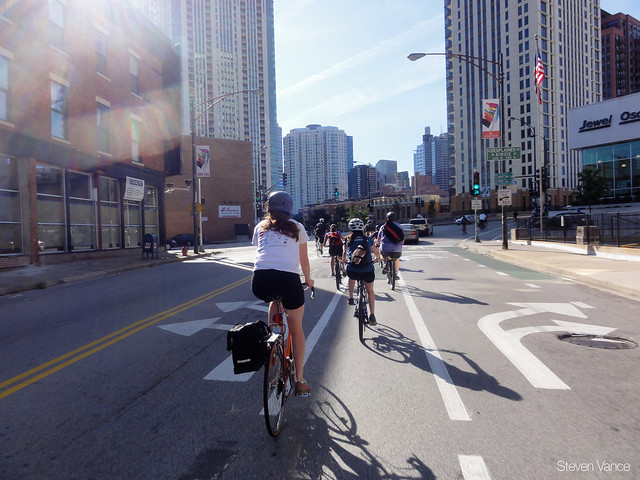Chicagoland has a lot of traffic congestion, according to this year's Urban Mobility Report from the Texas A&M Transportation Institute [PDF], yet we continue to build more roads while transit service and walking and biking facilities don't seem to increase as fast. Meanwhile, gas taxes and other fees on drivers fail to pay for all the roadbuilding, meaning we're subsidizing a very ineffective, inefficient system. A local campaign to implement congestion pricing holds the promise of easing congestion, reducing road subsides, and increasing investment in transit, biking, and walking -- but only if Chicago gets it right.
TTI released its annual Urban Mobility Report earlier this week, and lo and behold, Chicago is once again on the list of the country's most congested cities, along with New York, Los Angeles, and Washington, DC. This isn't exactly news. The report, which is based on a flawed methodology and often used to justify highway expansions, says the same thing every year: Congestion exerts a huge toll on our economy -- $121 billion in 2011. While the report has its flaws, maybe that dollar figure can be an impetus to reduce traffic on our streets. (Here's another one, which can't be so easily misconstrued to support wider roads: Traffic crashes cost our country $300 billion a year.)
The report authors make the standard recommendation to build more stuff, saying, "Projects that provide more road lanes and more public transportation service are part of the congestion solution package in most growing urban regions." But we know that building more roads doesn't reduce congestion. In fact, as former NJ DOT executive Gary Toth wrote on Streetsblog Capitol Hill yesterday, the TTI report is great proof that decades of highway building haven't solved the problem.
TTI's Chicago-specific report [PDF] shows that road capacity in the region continues to grow, as does the number of trips we make by car and by transit; the population is also slightly increasing. The authors don't expect biking and walking to grow any faster. Given current conditions, they have a point: Even though Chicago is adding bike lanes at a rapid clip, as long as driving remains heavily subsidized, it's harder for biking and walking – and transit – to compete.
The highway expansions coming soon to Chicagoland may further tilt the field toward driving. Thankfully, they are at least being tolled. Route 53 will be expanded northward at a cost of $200 million per mile, with a parkway-like design that's "friendly" to people on foot and riding bikes. The other project is the widening and lengthening of the Elgin-O'Hare Expressway, which would get closer to O'Hare (a western access route is still out of the question for now because of funding drama between the city and airlines). The entire highway will be converted to a toll road.
This conversion, approved by the U.S. DOT but waiting for state approval, has irked the Taxpayers United of America, which calls it "empire building" to "line [the Illinois Tollway's] pockets, get pay raises, and retire in pension glory." But tolling is perhaps the only fair way to pay for highways, because gas taxes certainly aren't doing it. As Streetsblog Capitol Hill recently reported, gas taxes and other fees on driving barely cover half the cost of America's road spending. The rest comes from general tax dollars.
A toll can also double as an effective long-term fix for traffic jams, if the price increases during times of day when travel demand is highest -- i.e. congestion pricing. The Chicago Metropolitan Agency for Planning, which created the GOTO2040 comprehensive regional plan, is campaigning for congestion pricing on five highways, including all lanes of the Route 53 extension. Other projects include adding an congestion-priced lane to I-90/Jane Addams (as opposed to converting an existing lane); congestion pricing all lanes on the Elgin-O'Hare expressway (instead of having a static toll on all lanes); converting a lane to a congestion-priced lane on I-290/Eisenhower (this corridor also has parallel rapid transit and commuter rail); and widening I-55/Stevenson to add a new congestion priced lane (versus converting an existing lane). The last three proposals are in the study phase.
Not all of these proposals would result in less traffic on Chicagoland streets, however. The ones that include additional road lanes are still going to induce more driving and dump more traffic on local streets. Much better are the proposals that put a price on roads without widening them, which can help shift trips from driving to transit, biking, and walking. An even better path forward would be to allocate some of those congestion pricing revenues to transit, bike, and pedestrian investments. That would give a major boost to improving train and bus systems while helping to ensure the region actually reaches the goals – like having bicycling account for 5 percent of trips under five miles in Chicago (currently it's less than 2 percent) – laid out in bike and pedestrian plans.







